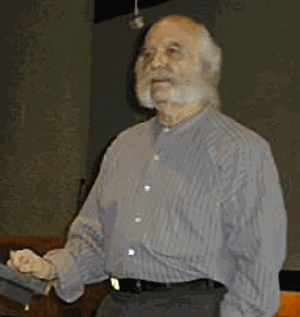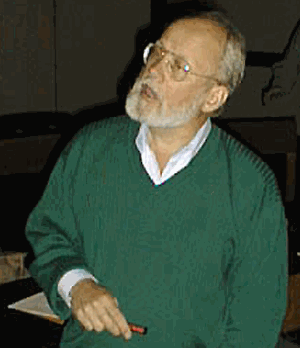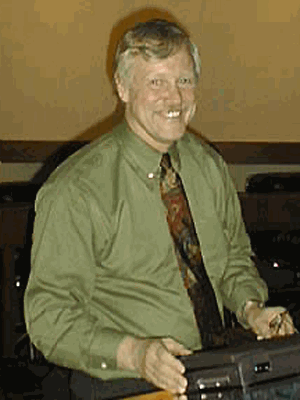
 |
1999 Research Symposium Presentations |
ARCC Annual Meeting Symposium
Saturday 30 October 1999
REFLECTING UPON ARCHITECTURAL RESEARCH
Henry Sanoff, G.Z. Charlie Brown, and John Carmody
Informal notes from presentations given at the Architectural Research Centers Consortium (ARCC) 1999 Research Symposium held in conjunction with the ARCC Annual Meeting, Washington, DC, 30 October 1999.
| Henry Sanoff
North Carolina State University |
 |
Henry Sanoff began by noting that he would present a personal view of research -- how context and personal predisposition affect research efforts. His journey to architectural research began with a discomfort with how things were done in day-to-day practice; namely a lack of connection to people and site. To move beyond his own culture he took an opportunity to do work in Jamaica. He was subsequently offered a job as research architect (50% teaching and 50% research) at the University of California-Berkeley. One of the first projects at Berkeley was for migrant worker housing; developing quality housing, but without air-conditioning. The funding was from a predecessor agency to HUD. The project involved setting up test cells and then making measurements and observations (the findings are still available in the literature under "low-income housing"). This experience involved expensive research, but no clear connection to teaching. The result was a schizophrenic existence.
Henry described how he then left Berkeley to accept a role as research architect at North Carolina State University (NCSU). NCSU had a research facility within the school of architecture; but it was just a large space for model testing, versus a space with carpet and typewriters. At NCSU Henry moved into investigations of people's reactions to buildings -- low budget research, with few assistants, but involving his first use of computers. This was followed by work on a housing survey in collaboration with Agricultural Extension. This was a larger project and included involvement of Henry's studio students. This mode of operation, however, had too great a turnover in assistants, so graduate students were hired as research staff.
In this mode of operation, Henry noted that he then spent most of his time finding funding. He subsequently decided to close the research lab and focus on studio -- as a research-based studio setting. The key issue with this approach is that studio teaches students to think globally. The research element teaches students to draw boundaries around problems. Henry has been teaching research-based studios for around 30 years now. It is critical that such studios involve real projects with real clients. Participating students develop a set of tools that is of great value in practice -- general research skills, outreach techniques, and communication capabilities. Such tools are a way to empower students and allow them to support their design decisions.
North Carolina State University's School of Design now has a Ph.D. program. This allows students to engage in research and a research focus in settings beyond the studio.
| G.Z. (Charlie)
Brown
University of Oregon |
 |
Charlie Brown titled his presentation "How to Make Research Work." This title and question are connected to his work as coordinator of the Energy Studies in Buildings Laboratory (ESBL) at the University of Oregon and to a personal goal of looking at environment and architecture as the two are linked by energy usage. Charlie=s presentation posed a series of interrelated questions.
First -- How does one select problems to research? This basic question raises subsidiary questions: fundamental versus applied knowledge as a focus; what is "architectural;" how does one "prove" results; does research lead one to become a brick maker or a wall builder? A review of work at the ESBL on structural insulated panels (SIP) illustrated the nature of these questions. How to build a "problem" from a potential solution, establish a research program with a 20-year life and multiple possible directions, good funding potential, and using the first grant to support development of "your" problem?
Second -- How does one find time for research? Charlie stressed that it is essential to connect research to teaching and to use students as a source of research ideas. There was a recurring emphasis on "leveraging," of getting 2-for-1 or 3-for-1 overlaps from all efforts. It was suggested that the science model for course loads be used versus the humanities model.
Third -- How to get funding for research? It is critical to use all opportunities, both competitive solicitations and non-competitive. Creative use of matching funds should be considered. Project titles and focus should evolve over time and for different funding sources. Historically, there is a 6- or 8-to-1 ratio of proposals written versus proposals funded. Large government grants are usually political. In order to be successful a proposer should: (1) know the terminology of the granting group; (2) get in-house and external reviews of proposals; (3) understand the percentage of proposals likely to be funded and one's chances; and (4) seek at least $50,000 and multi-year grants.
Fourth -- How to hire good people? Charlie's advice is to hire students (many), researchers (some), and faculty (few). All those hired should have a knowledge base, ability, a diverse attitude, good work habits, and potential. Some who are hired should have management skills, some networking skills, and some originality.
Fifth -- How to get the work done? Charlie gave an interesting take on this issue; bite off more than you can chew and then modify the work plan. Sixth -- How to get research used? Disseminate results of research by all means available; papers, reports, and built projects.
Another question that comes to mind is "Why bother?" Architectural research can be stimulating, important, meaningful, and educates a cadre of future researchers and practitioners.
| John Carmody University of Minnesota |
 |
John Carmody is currently with the College of Architecture and Landscape Architecture, Building Research Group. John related that he graduated with a degree in architecture, but had no desire to engage in normal practice. He teamed up with civil engineering faculty and researchers for research into underground space usage. This group had few links to other university departments, and eventually was closed. John moved to the Minnesota Housing Research Center, which operated for 10 years but also eventually was closed -- likely due to its lack of links to other parts of the university.
John is now affiliated with the architecture program at the university, where substantial links to teaching exist. These links provide a different feel to the research efforts. As an example, human factors research related to roadway design used simulations of driving conditions -- a tool that had not previously been used and which yielded interesting results. Current research also involves windows design and application. An interesting feature of this work is the link to a defined industry with clear interests and identity. An educational World Wide Web site developed in conjunction with this work may eventually become a commercially-supported enterprise.
A building evaluation project for the Department of Natural Resources began with the perception that the Department was not getting the "best" buildings as a matter of course. What could be done to improve this situation? This project involved crossing traditional boundaries and changing practices. Another recent project involves developing a Web-based sustainability guide for Minnesota. This is essentially a means of developing a knowledge base through iterations on successive building projects. Sustainability is used as an umbrella for a range of issues, some of which might not be individually fundable but which work integrally as part of a larger holistic solution.
![]() Back to ARCC Homepage |
Back to ARCC Homepage | ![]() Back to Research Exchange
Back to Research Exchange
This page was last updated on 22 April 2008.
http://www.polaris.net/~arcc/web/dcsym99.htm